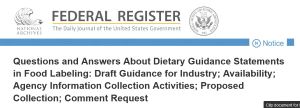The Vegetarian Resource Group Testimony Concerning Dietary Guidance Statements on Food Labels Submitted to U.S. Food and Drug Administration (FDA)
We are generally in agreement with the concept that quick signals on the front of packages help consumers better understand nutrition information. The proposed guidance for industry is generally understandable and useful. We agree that nut or seed products that do not exceed the recommended levels for sodium and added sugars should be allowed to include a Dietary Guidance Statement despite exceeding the recommended saturated fat level. As discussed in the proposed guidance, nuts and seeds are considered nutrient dense foods, have a fat profile of predominantly monounsaturated and polyunsaturated fats, and consumption of these foods is associated with beneficial health outcomes.
We are pleased to see that the proposed guidance supports “the use of Dietary Guidance Statements on all plant-based milk and yogurt alternatives – not just soy based alternatives (page 22). This inclusion of additional plant-based milk and yogurt alternatives allows for flexibility and for the inclusion of newly developed products rather than limiting use of Dietary Guidance Statements to only products that are based on soy. We agree that plant-based milks and yogurt should meet specific recommendations for overall nutrient content but encourage the FDA to review and consider revision of USDA’s FNS fluid milk substitutes nutrient criteria. For example, these criteria call for plant-based milks to contain 8 grams of protein per 8 ounce serving. Protein is rarely deficient in diets of Americans so a relaxation of this requirement, perhaps to 4 grams or 6 grams of protein per 8 ounce serving, is unlikely to have negative health consequences. This relaxation could allow greater variety in those fortified non-dairy products that could include Dietary Guidance Statements.
We are concerned that in situations when a food is recommended by a consensus report as part of a
nutritious dietary pattern and the food has a nutrient profile that exceeds the recommended nutrient levels in this guidance, the product could bear both a Dietary Guidance Statement and a disclosure
statement about the recommended nutrient level(s) it exceeds (page 30). This results in a potentially
confusing mixed message that does not achieve the goal of helping consumers, especially those with
lower nutrition or health literacy, to better understand nutrition information. For example, in Figure 4, our initial impression was that the message was saying that yogurt is a good way to obtain added sugars.
At a minimum, this mixed messaging should be tested with consumers to determine what the
consumers perceive about a statement saying, “choose this food” and “this food is high in added
sugars/saturated fat/sodium.” If further investigation suggests consumer confusion, products that
exceed recommended nutrient levels from added sugar, sodium, or saturated fat (with the exception of
nut and seed products), should not be able to bear a Dietary Guidance Statement under any
circumstances.
Thank you for the opportunity to comment on this issue.

